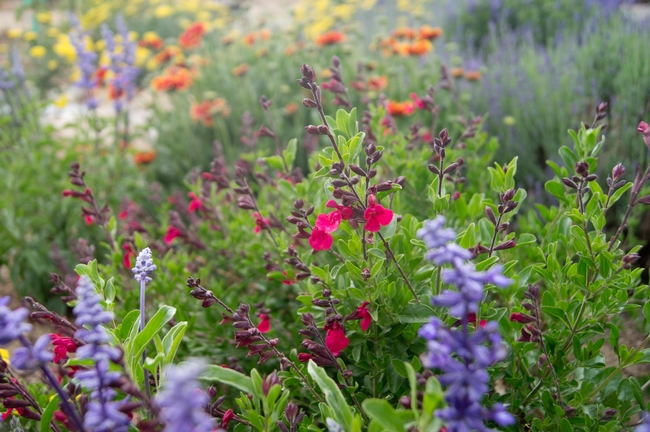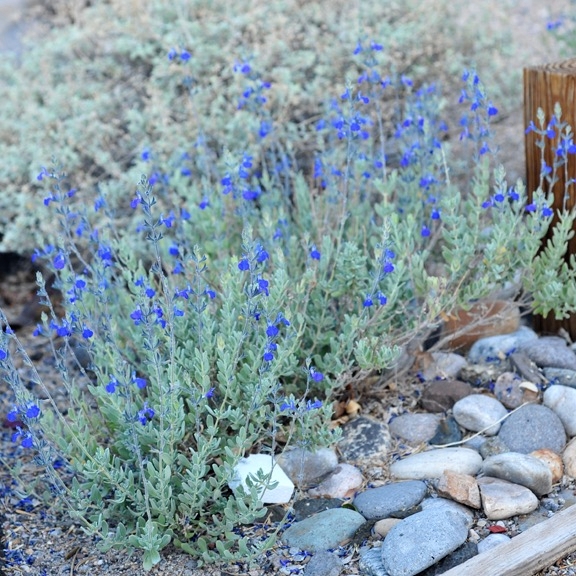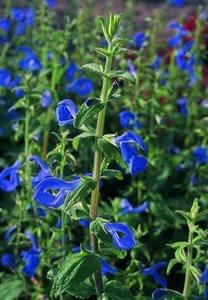Last time, we had an introduction to the Salvia genus, which is a diverse group of close to 1,000 species. One of the most widely planted locally is Salvia farinacea. Fortunately, it's more appealing than its common name, mealycup sage, and while it's not one of my absolute favorites, it gets high marks for nonstop blooming and vigorous self-seeding. Though a native of Texas and New Mexico, it's not particularly xeric. ‘Victoria' is the most common cultivar locally, but many others are more desirable. I planted ‘Blue Bedder,' which is taller, from seed. Also easy from seed is Salvia patens ‘Blue Angel.' This has one of the most enchanting blooms of all salvias. unfortunately, it is one of many salvias rated for zones 8-10 perennials. However, if you're growing them from seed, at least it's not costing you much money! Nearly as beautiful, twice as tall, and easily surviving our winters is Salvia azurea grandiflora. This is another one I grew easily from seed. I'm gonna put in another plug here for my source for these. Diane's Seeds has an interesting selection of small, cheap seed packets, friendly personal service and super fast delivery. As long as we're at it, my other favorite seed source—this one for natives and grasses—is Plants of the Southwest in New Mexico.
While all the above are varying shades of blue—the predominant color in the species—salvias do come in nearly all colors, and the best place to find them is in what is probably the most valuable landscaping salvia species for gardeners in the eastern Sierra—Salvia greggii. True to its common name—autumn sage—these are spectacular in the fall when a lot of other flowers have ended their show, but in our area they are pretty much nonstop bloomers from April through July. 
An invaluable plant for the front of my garden is Salvia nemorosa. Nemorosa means “of the woods,” so the common name is woodland sage or Balkan clary. ‘May Night' and ‘East Friesland' are two commonly available purple varieties, while ‘Rose Queen' has been showing up locally the last few years as well. I have not tried Salvia nemorosa from seed, but the plants do self-sow and can be divided after a few years. Like many of the salvias, these bloom profusely in the spring, but if you cut back the blooms you can pretty much get blooms throughout the growing season.
Not nearly as well known, and seldom found locally, is Salvia chamaedryoides. Germander sage is native to the high desert of the Sierra Madre Oriental in Mexico (hence, its other common name of Mexican blue sage). 
California native plant lovers will notice a glaring omission—Salvia dorrii, our local purple sage. It does have spectacular blooms and is very drought tolerant. I have a few in my yard, but to my mind they just don't give me enough bang for the buck to be worth planting more widely. Salvia chamaedryoides is similar in leaf and flower color, but way more robust. In my yard anyway, for most of the growing season, Salvia dorrii is a bit scraggly and nondescript. I know it may offend the purists, and maybe I just don't know how to handle this species, but it doesn't seem worth the effort when so many other salvias are available.
One of my neighbors has a plant that is pretty close, Salvia pachyphylla. High Country Gardens no longer seems to have it, but I just checked my new favorite website, Flowers by the Sea, and they have it, so perhaps I'll give it a try. Check out this article from the Salvia Guru newsletter about flora of SoCal's Santa Rosa Mountains, featuring spectacular pictures of Salvia pachyphylla.
I almost forgot another spectacular plant, Salvia clevelandii. This 3-foot shrub is native to the chaparral of southern California. This is another one that needs the right location to survive our winters. I have two framing our patio on the south side of the house, and they have flourished there for several years now. They have big, beautiful Salvia dorrii -like blossoms, but the best thing about this plant is its aroma. This is by far the best-smelling plant I know. It would be worth it just for the smell, but like nearly all its cousins in the salvia genus, it has attractive foliage, low water needs and is a haven for wildlife. Every garden has room for at least a few salvias.
